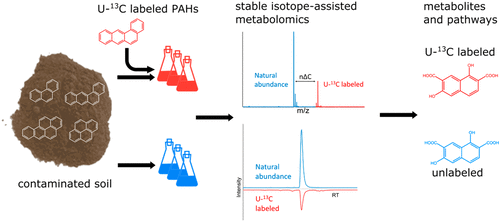当前位置:
X-MOL 学术
›
Environ. Sci. Technol. Lett.
›
论文详情
Our official English website, www.x-mol.net, welcomes your
feedback! (Note: you will need to create a separate account there.)
Tracing the Biotransformation of Polycyclic Aromatic Hydrocarbons in Contaminated Soil Using Stable Isotope-Assisted Metabolomics
Environmental Science & Technology Letters ( IF 8.9 ) Pub Date : 2018-01-05 00:00:00 , DOI: 10.1021/acs.estlett.7b00554 Zhenyu Tian 1 , Joaquim Vila 1 , Miao Yu 2 , Wanda Bodnar 1 , Michael D. Aitken 1
Environmental Science & Technology Letters ( IF 8.9 ) Pub Date : 2018-01-05 00:00:00 , DOI: 10.1021/acs.estlett.7b00554 Zhenyu Tian 1 , Joaquim Vila 1 , Miao Yu 2 , Wanda Bodnar 1 , Michael D. Aitken 1
Affiliation

|
Biotransformation of organic pollutants may result in the formation of oxidation products that are more toxic than the parent contaminants. However, tracing and identifying those products, and the metabolic pathways involved in their formation, are still challenging within complex environmental samples. We applied stable isotope-assisted metabolomics (SIAM) to polycyclic aromatic hydrocarbon-contaminated soil collected from a wood treatment facility. Soil samples were separately spiked with uniformly 13C-labeled fluoranthene, pyrene, or benzo[a]anthracene at a level below that of the native contaminant and incubated for 1 or 2 weeks under aerobic biostimulated conditions. Combining high-resolution mass spectrometry and automated SIAM workflows, we propose chemical structures of metabolites and metabolic pathways in the soil. Ring-cleavage products, including previously unreported intermediates such as C11H10O6 and C15H12O5, were detected originating from fluoranthene and benzo[a]anthracene, respectively. Sulfate conjugates of dihydroxy compounds were found as major metabolites of pyrene and benzo[a]anthracene, suggesting the potential role of fungi in their biotransformation in soils. A series of unknown N-containing metabolites were identified from pyrene, but their structural elucidation requires further investigation. Our results suggest that SIAM can be successfully applied to understand the fate of organic pollutants in environmental samples, opening lines of evidence for novel mechanisms of microbial transformation within such complex matrices.
中文翻译:

使用稳定的同位素辅助代谢组学追踪污染土壤中多环芳烃的生物转化
有机污染物的生物转化可能导致形成比母体污染物毒性更大的氧化产物。然而,在复杂的环境样品中,追踪和鉴定这些产物以及涉及其形成的代谢途径仍然具有挑战性。我们对从木材处理厂收集的多环芳烃污染的土壤应用了稳定的同位素辅助代谢组学(SIAM)。用13 C标记的荧蒽,pyr或苯并[ A]分别向土壤样品中加标。蒽的含量低于天然污染物的水平,并在有氧生物刺激条件下孵育1或2周。结合高分辨率质谱法和自动SIAM工作流程,我们提出了土壤中代谢物的化学结构和代谢途径。环裂解产物,包括先前未报告的中间体,例如C 11 H 10 O 6和C 15 H 12 O 5,被检测到分别来自荧蒽和苯并[ a ]蒽。发现二羟基化合物的硫酸盐共轭物是pyr和苯并[ a]的主要代谢物。蒽,表明真菌在土壤生物转化中的潜在作用。从pyr中鉴定出一系列未知的含氮代谢产物,但其结构阐明尚需进一步研究。我们的结果表明,SIAM可以成功地用于理解环境样品中有机污染物的命运,从而为此类复杂基质中微生物转化的新机制开辟了证据。
更新日期:2018-01-05
中文翻译:

使用稳定的同位素辅助代谢组学追踪污染土壤中多环芳烃的生物转化
有机污染物的生物转化可能导致形成比母体污染物毒性更大的氧化产物。然而,在复杂的环境样品中,追踪和鉴定这些产物以及涉及其形成的代谢途径仍然具有挑战性。我们对从木材处理厂收集的多环芳烃污染的土壤应用了稳定的同位素辅助代谢组学(SIAM)。用13 C标记的荧蒽,pyr或苯并[ A]分别向土壤样品中加标。蒽的含量低于天然污染物的水平,并在有氧生物刺激条件下孵育1或2周。结合高分辨率质谱法和自动SIAM工作流程,我们提出了土壤中代谢物的化学结构和代谢途径。环裂解产物,包括先前未报告的中间体,例如C 11 H 10 O 6和C 15 H 12 O 5,被检测到分别来自荧蒽和苯并[ a ]蒽。发现二羟基化合物的硫酸盐共轭物是pyr和苯并[ a]的主要代谢物。蒽,表明真菌在土壤生物转化中的潜在作用。从pyr中鉴定出一系列未知的含氮代谢产物,但其结构阐明尚需进一步研究。我们的结果表明,SIAM可以成功地用于理解环境样品中有机污染物的命运,从而为此类复杂基质中微生物转化的新机制开辟了证据。











































 京公网安备 11010802027423号
京公网安备 11010802027423号